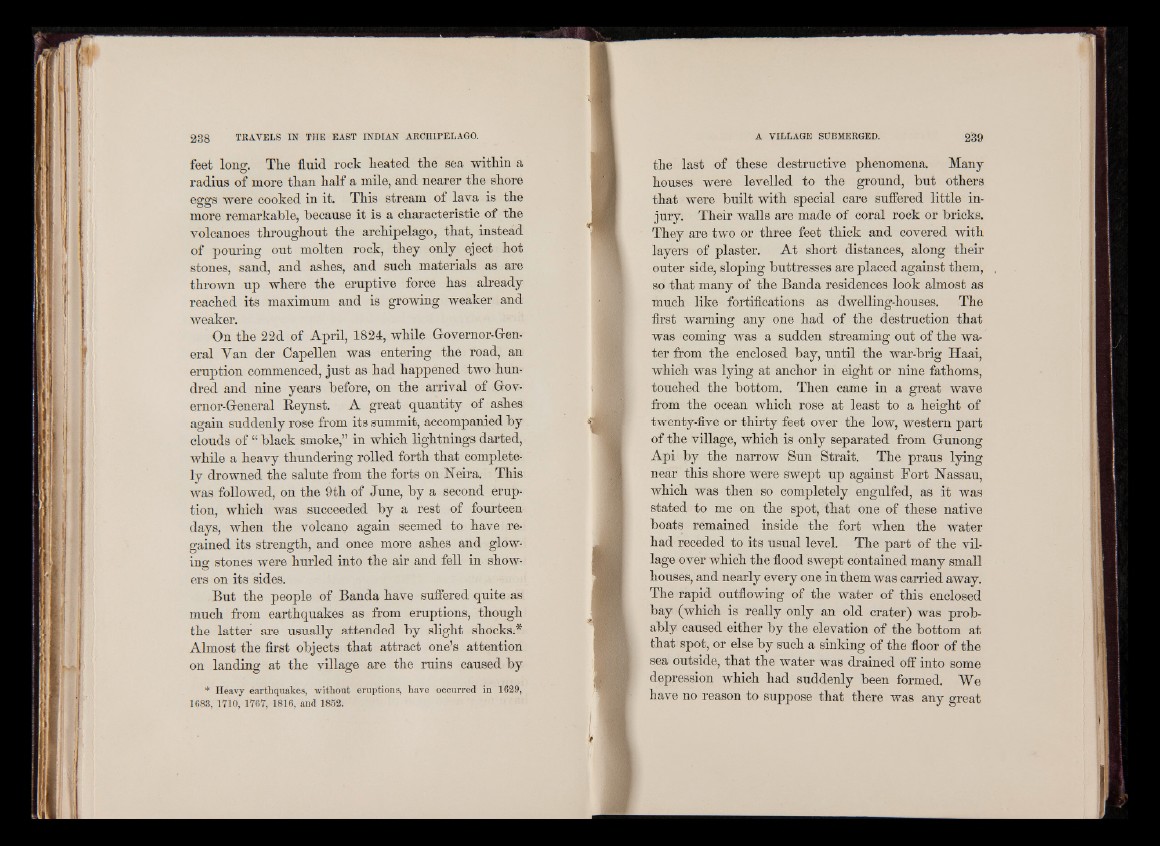
feet long. The fluid rock heated the sea within a
radius of more than half a mile, and nearer the shore
eggs were cooked in it. This stream of lava is the
more remarkable, because it is a characteristic of the
volcanoes throughout the archipelago, that, instead
of pouring out molten rock, they only eject hot
stones, sand, and ashes, and such materials as are
thrown up where the eruptive force has already
reached its maximum and is growing weaker and
weaker.
On the 2 2 d of April, 1824, while Governor-General
Van der Capellen was entering the road, an
eruption commenced, just as had happened two hundred
and nine years before, on the arrival of Governor
General Reynst. A great quantity of ashes
again suddenly rose from its summit, accompanied by
clouds of “ black smoke,” in which lightnings darted,
while a heavy thundering rolled forth that completely
drowned the salute from the forts on Neira. This
was followed, on the 9th of June, by a second eruption,
which was succeeded by a rest of fourteen
days, when the volcano again seemed to have regained
its strength, and once more ashes and glowing
stones were hurled into the air and fell in show-
ers on its sides.
But the people of Banda have suffered quite as
much from earthquakes as from eruptions, though
the latter are usually attended by slight shocks.*
Almost the first objects that attract one’s attention
on l a n d i n g at the village are the ruins caused by
* Heavy earthquakes, without eruptions, have occurred in 1629,
1683, 1710, 1767, 1816, and 1852.
the last of these destructive phenomena. Many
houses were levelled to the ground, but others
that were built with special care suffered little injury.
Their walls are made of coral rock or bricks.
They are two or three feet thick and covered with
layers of plaster. At short distances, along their
outer side, sloping buttresses are placed against them,
so that many of the Banda residences look almost as
much like fortifications as dwelling-houses. The
first warning any one had of the destruction that
was coming was a sudden streaming out of the water
from the enclosed bay, until the war-brig Haai,
which was lying at anchor in eight or nine fathoms,
touched the bottom. Then came in a great wave
from the ocean which rose at least to a height of
twenty-five or thirty feet over the low, western part
of the village, which is only separated from Gunong
Api by the narrow Sun Strait. The praus lying
near this shore were swept up against Fort Nassau,
which was then so completely engulfed, as it was
stated to me on the spot, that one of these native
boats remained inside the fort when the water
had receded to its usual level. The part of the village
over which the flood swept contained many small
houses, and nearly e very one in them was carried away.
The rapid outflowing of the water of this enclosed
bay (which is really only an old crater) was probably
caused either by the elevation of the bottom at
that spot, or else by such a sinking of the floor of the
sea outside, that the water was drained off into some
depression which had suddenly been formed. We
have no reason to suppose that there was any great